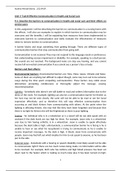Audrey Mensah Bonsu . 25219439 .
Unit 3’ Task B Effective Communication in Health and Social Care
P.3. Describe the barriers to communication in health and social care and their effects on
service users
In this assignment I will be describing the barriers to communication in a nursing home with
the effects, I will also use examples to explain in which barriers to communication may be
overcome and the benefits. I will be explaining how measures have been implemented to
overcome barriers to communication and lastly evaluate the effectiveness of measures
taken to remove barriers to communication.
A barrier blocks and stops something from getting through. There are different types of
communication barriers that stop communication from going well.
Communication is not received: They may not respond to the language needs or preferences.
Not understanding sensory impairment or disability. For example, speaking to a deaf person,
the sounds are not received. The background noise can stop you hearing, and you cannot
receive full non-verbal communication if you cannot see a person’s face or body.
Barriers and their effects:
Environmental barriers: Environmental barriers are Time, Place, Space, Climate and Noise.
Some of them are anything but difficult to adjust though, some may turn out to be extreme
snags during the time spent compelling communication. These factors may noble cause
distractions prompting mindlessness or thoroughly adjust the message, causing
miscommunication.
Lighting - Somebody who doesn't see will battle to read and written information due to the
dimly of the room. For example, lighting can also be a communication barrier for Kristen as
her face may not be seen clearly, the carer will not be able to lip read or see her facial
expression effectively, and so therefore this will stop effective communication from
occurring as and block Kristen from communicating with others. At the point when the
lighting is affecting Kristen, she may feel like they have been forgotten and because that
there is no light for Kristen she will feel frightened as there is poor lighting.
Seating - An individual who is in a wheelchair or is a dwarf will be not able speak with an
assistant if the desk levels are too high for them. For example, Jason who is a wheelchair
user due to him having arthritis, is in a wheelchair. Jason is unable to speak effectively
because the desk table is high. unfortunately, a communication barrier he is facing is he is
unable to hear or see what his receptionist is trying to communicate so he is unable to
receive important messages. As the desk is high, it blocks Jason from communicate with
people. Jason may feel left out which implies for him to not speak to anyone, as he has been
put to the side.
External noise - Somebody with a hearing or speech disability most likely would not be able
to communicate right if there are too much noises being made; no information will be able
to be received. For example, Ruth who has Asthma and high blood pressure has been sat
down next to the heater which is making so much noise plus It has been turned on high;
1





